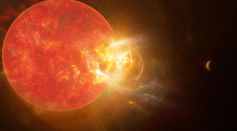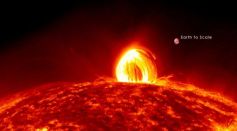Tags: Sun

Artificial Intelligence Improves NASA's Sun Images, Solar Dynamics Observatory Says
Moon-Forming Disc Discovered Around Very Young 5.4 Million-Year-Old Jupiter-Like Exoplanet; Astronomers Consider Their Discovery Important
How Can Planets Survive White Dwarf's Stellar Evolution? Signs of Life on Planet Near a Dying Star Impossible
Why Do Asteroids and Comets Have Weird Shape? The Reason Behind Moon and Star's Spherical Shape Explained

Extreme Solar Activities Detected Through Tree-Ring Dating Back From 5,410 BCE

Largest X-Class Solar Flare: Why It is Impossible for "Killer Solar Flare" to Destroy Earth
Aphelion 2021: What to Expect When Earth Is at Its Furthest from the Sun
Earth Faces First X Class Flare for Solar Cycle 25; Here's What It Means
Mercury Explained: Understanding Its Iron Core and the Sun's Magnetism

Strawberry Moon: It's Time! Know Some Important Things About the Last Supermoon of 2021
Total Solar Eclipses Shed Light on the Temperature of Solar Winds and Sun's Corona
USPS Issues New Sun Science Stamps Showcasing Different Solar Activity as Seen From Space
Solar Physicists Confirmed Planetary Hypothesis Through Sun's Clock
Rosetta Eruption: New Hints Revealed About Solar Explosions

Solar Eclipse 2021: How To See Rare 'Ring of Fire' for First Time in 4 Years
Ring of Fire Solar Eclipse 2021: Where and How to Watch This Rare Event
Solar Wind, Space Weather Poses Threats to Technology? Experts Study Direction of Winds on Sun's Surface
Why is Sun's Atmosphere Hot? Here's What Scientists Say
Space Solar Power Could Revolutionize Energy As US Air Force Plans to Harvest This Unlimited Source

How Does Solar Eruption Look Like? Here's the Description of NASA's Solar Orbiter
Most Popular

10 Weird Things the Human Body Does—and the Science Behind These Biological Mysteries

Top Space Technology Trends and Aerospace Innovations Revolutionizing the World Today

Why Mega Typhoons Keep Getting Stronger: The Science Behind Typhoon Formation and Extreme Weather

How Plate Tectonics Trigger Earth's Most Dangerous Disasters Through Powerful Seismic Hazards




